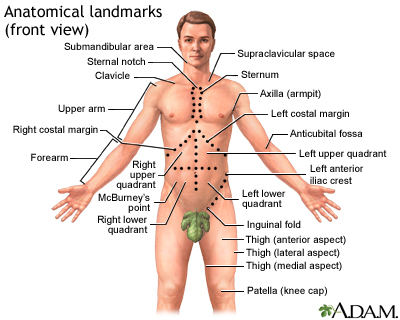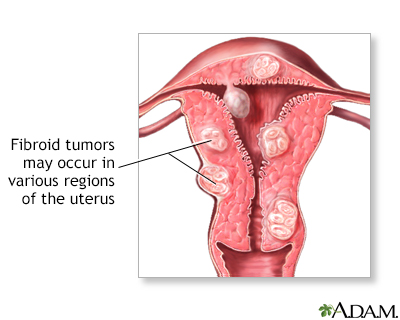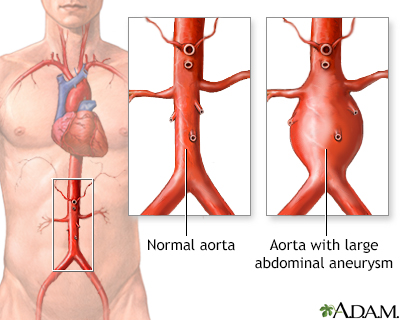Abdominal mass
Mass in the abdomen
An abdominal mass is swelling in one part of the belly area (abdomen).
Images




I Would Like to Learn About:
Considerations
An abdominal mass is often found during a routine physical exam. Most of the time, the mass develops slowly. You may not be able to feel the mass.
Locating the mass helps your health care provider make a diagnosis. For example, the abdomen can be divided into four areas:
- Right-upper quadrant
- Left-upper quadrant
- Right-lower quadrant
- Left-lower quadrant
Other terms used to describe the location of abdominal pain or masses include:
- Epigastric -- center of the abdomen just below the rib cage
- Periumbilical -- area around the belly button
The location of the mass and its firmness, texture, and other qualities can provide clues to its cause.
Causes
Several conditions can cause an abdominal mass:
- Abdominal aortic aneurysm can cause a pulsating mass around the navel.
- Bladder distention (urinary bladder over-filled with fluid) can cause a firm mass in the center of the lower abdomen above the pelvic bones. In extreme cases, it can reach as far up as the navel.
- Cholecystitis can cause a very tender mass that is felt below the liver in the right-upper quadrant (occasionally).
- Colon cancer can cause a mass almost anywhere in the abdomen.
- Crohn disease or bowel obstruction can cause many tender, sausage-shaped masses anywhere in the abdomen.
- Diverticulitis can cause a mass that is usually located in the left-lower quadrant.
- Gallbladder tumor can cause a tender, irregularly shaped mass in the right-upper quadrant.
- Hydronephrosis (fluid-filled kidney) can cause a smooth, spongy-feeling mass in one or both sides or toward the back (flank area).
- Kidney cancer can sometimes cause a smooth, firm, but not tender mass in the abdomen.
- Liver cancer can cause a firm, lumpy mass in the right upper quadrant.
- Liver enlargement (hepatomegaly) can cause a firm, irregular mass below the right rib cage, or on the left side in the stomach area.
- Neuroblastoma, a cancerous tumor often found in the lower abdomen can cause a mass (this cancer mainly occurs in children and infants).
- Ovarian cyst can cause a smooth, rounded, rubbery mass above the pelvis in the lower abdomen.
- Pancreatic abscess can cause a mass in the upper abdomen in the epigastric area.
- Pancreatic pseudocyst can cause a lumpy mass in the upper abdomen in the epigastric area.
- Pregnancy causes a mass above the pelvis in the lower abdomen that may be mistaken for an illness.
- Spleen enlargement (splenomegaly) can sometimes be felt in the left-upper quadrant.
- Stomach cancer can cause a mass in the left-upper abdomen in the stomach area (epigastric) if the cancer is large.
- Uterine leiomyoma (fibroids) can cause a round, lumpy mass above the pelvis in the lower abdomen (sometimes can be felt if the fibroids are large).
- Volvulus can cause a mass anywhere in the abdomen.
- Ureteropelvic junction obstruction can cause a mass in the lower abdomen.
Home Care
All abdominal masses should be examined as soon as possible by the provider.
Changing your body position may help relieve pain due to an abdominal mass.
When to Contact a Medical Professional
Get medical help right away if you have a pulsating lump in your abdomen along with severe abdominal pain. This could be a sign of a ruptured aortic aneurysm, which is an emergency condition.
Contact your provider if you notice any type of abdominal mass.
What to Expect at Your Office Visit
In nonemergency situations, your provider will perform a physical exam and ask questions about your symptoms and medical history.
In an emergency situation, you will be stabilized first. Then, your provider will examine your abdomen and ask questions about your symptoms and medical history, such as:
- Where is the mass located?
- When did you notice the mass?
- Does it come and go?
- Has the mass changed in size or position? Has it become more or less painful?
- What other symptoms do you have?
- Is it possible that you are pregnant?
A pelvic or rectal exam may be needed in some cases. Tests that may be done to find the cause of an abdominal mass include:
- Abdominal and pelvic CT scan
- Abdominal and pelvic ultrasound
- Angiography
- Barium enema
- Blood tests
- Colonoscopy
- Esophagogastroduodenoscopy (EGD)
- Paracentesis
- Sigmoidoscopy
- Stool analysis
- Urine tests
- X-rays of the chest or abdomen
Related Information
Physical examinationAbscess
Aneurysm
Tumor
References
Ball JW, Dains JE, Flynn JA, Solomon BS, Stewart RW. Abdomen. In: Ball JW, Dains JE, Flynn JA, Solomon BS, Stewart RW, eds. Seidel's Guide to Physical Examination. 10th ed. St Louis, MO: Elsevier; 2023:chap 18.
Landmann A, Bonds M, Postier R. Acute abdomen. In: Townsend CM Jr, Beauchamp RD, Evers BM, Mattox KL, eds. Sabiston Textbook of Surgery. 21st ed. St Louis, MO: Elsevier; 2022:chap 46.
McQuaid KR. Approach to the patient with gastrointestinal disease. In: Goldman L, Cooney KA, eds. Goldman-Cecil Medicine. 27th ed. Philadelphia, PA: Elsevier; 2024:chap 118.
BACK TO TOPReview Date: 10/9/2024
Reviewed By: Linda J. Vorvick, MD, Clinical Professor, Department of Family Medicine, UW Medicine, School of Medicine, University of Washington, Seattle, WA. Also reviewed by David C. Dugdale, MD, Medical Director, Brenda Conaway, Editorial Director, and the A.D.A.M. Editorial team.

Health Content Provider
06/01/2025
|
A.D.A.M., Inc. is accredited by URAC, for Health Content Provider (www.urac.org). URAC's accreditation program is an independent audit to verify that A.D.A.M. follows rigorous standards of quality and accountability. A.D.A.M. is among the first to achieve this important distinction for online health information and services. Learn more about A.D.A.M.'s editorial policy, editorial process and privacy policy. A.D.A.M. is also a founding member of Hi-Ethics. This site complied with the HONcode standard for trustworthy health information from 1995 to 2022, after which HON (Health On the Net, a not-for-profit organization that promoted transparent and reliable health information online) was discontinued. |
The information provided herein should not be used during any medical emergency or for the diagnosis or treatment of any medical condition. A licensed medical professional should be consulted for diagnosis and treatment of any and all medical conditions. Links to other sites are provided for information only -- they do not constitute endorsements of those other sites. © 1997- 2025 A.D.A.M., a business unit of Ebix, Inc. Any duplication or distribution of the information contained herein is strictly prohibited.
